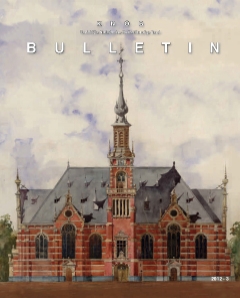Indexering ESCI / Scopus


Pepijn van Doesburg: Woekeren met de ruimte. Nieuw licht op de middeleeuwse plannen voor zuidwaartse voltooiing van het Domschip te Utrecht. Simon Groenveld: Schenkingen van gebrandschilderde glazen in Holland in de zestiende en zeventiende eeuw. Ontwikkelingen in argumenten en methoden. Gerhard Geerken: ‘Die Vorliebe der Niederländer für helle, freundliche Zimmer’. Oldenburgs stucwerk in Nederland tussen 1775 en 1925. Niels van Neck: Een Apeldoorns ‘onderonsje’. De veelbesproken prijsvraag voor een protestantse kerk te Apeldoorn (1890-1891).
The nave of Utrecht cathedral was never completed, which contributed to its collapse during a heavy storm in 1674. The vaults in the central nave and the flying buttresses to shore them were not executed. On the southern side the Heilig-Kruiskapel (Holy Cross Chapel), which belonged to the adjacent chapter of Oudmunster, prevented the complete extension of the nave according to the original seven-aisle layout. Attempts of the dean and chapter to have the chapel moved came to nothing.
After the storm of 1674 three realized southern nave chapels survived. The westernmost of them,...
Donations of stained-glass windows in the Northern Netherlands are referred to from the end of the fourteenth century, which is late from an international point of view. Frequently, such windows were donated by notables: members of the clergy, royal and noble administrators. Their motivation was primarily spiritual: performing a good deed, which according to the teachings of the Church of Rome contributed to the eternal salvation of the donor’s soul. The representations on the windows, for the most part placed during new construction, extension or restoration, were predominantly...
‘Dutchmen like light, representative interiors’, according to several Germans in the nineteenth century. They referred to the taste in living of above-average citizens. Evidently, there was a preference for white, sometimes also for bright colours. In the period 1775-1925 more than a thousand Oldenburg plasterers earned a living from the taste of Dutch citizens. The farmer’s son J.B. Logeman (1748-1814) from Oldenburg was the first. In Amsterdam he learned the plasterer’s craft and was quite successful in the Northern Netherlands and Germany. This inspired people from the same regions....
The proceedings of the competition were also influenced by the fact that the protestant religious conviction of the commissioning authority and the accompanying requirements a church building had to comply with, did not appear to have played an equally important role for all the parties involved in the competition, which was of overriding importance for the outcome. In the explanations of the designs of a number of participating architects the importance of a good view of the pulpit and good acoustics are prominent. In the jury report typically protestant requirements concerning hearing...


open access mogelijk gemaakt door Stichting OpenAccess
